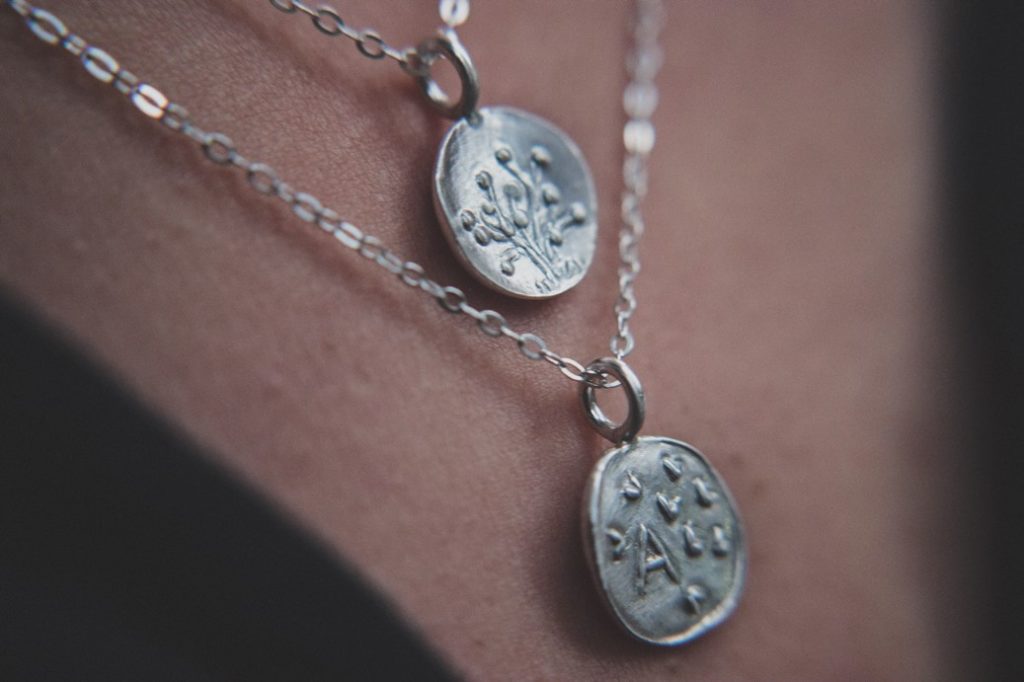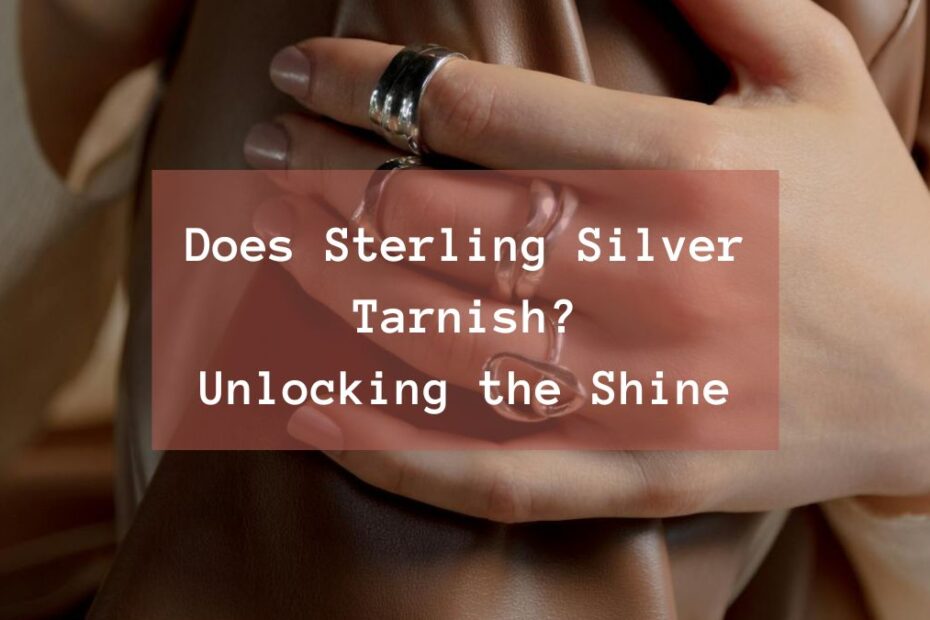Picture this: you open your jewelry box, eager to adorn yourself with your favorite sterling silver necklace, only to be greeted by a dull, tarnished surface that has lost its luster. It’s a disappointing sight, one that many jewelry enthusiasts have encountered at some point. But fear not! The tale of tarnished sterling silver is a common one, and there are ways to combat this pesky problem and restore your beloved pieces to their former glory.
In this article, we embark on a journey to uncover the essence of sterling silver and shed light on the phenomenon of tarnishing that often plagues this beautiful metal. Our objective is to provide readers with valuable insights into the nature of sterling silver, its unique characteristics, and practical tips for preventing and managing tarnish effectively. So, let’s dive in and discover how to keep your sterling silver shining bright for years to come!
Table of Contents
Understanding Sterling Silver – Composition & Significance
What is Sterling Silver?
Sterling silver, often referred to simply as “silver,” is a precious metal renowned for its brilliant luster and versatility in jewelry-making. It is composed primarily of silver, typically containing 92.5% pure silver and 7.5% other metals, such as copper or zinc. This combination enhances the durability and strength of sterling silver, making it suitable for crafting exquisite jewelry pieces that withstand the test of time.
Significance
Throughout history, sterling silver has held immense cultural and symbolic significance, transcending mere adornment to become a cherished symbol of wealth, status, and artistic expression. From ancient civilizations to modern-day societies, sterling silver has been prized for its timeless beauty and intrinsic value.
- Cultural Significance: Sterling silver’s versatility knows no bounds in jewelry-making, seamlessly transitioning from classic designs to contemporary styles, catering to diverse tastes and preferences. Whether adorning a regal crown or a delicate pendant, sterling silver exudes an aura of sophistication and elegance, making it a perennial favorite among jewelry enthusiasts worldwide.
- Historical Significance: Sterling silver has a rich history dating back centuries, with its origins rooted in ancient civilizations such as Egypt, Greece, and Rome. Over time, it has evolved into a symbol of luxury and refinement, cherished by artisans and connoisseurs alike for its unmatched beauty and craftsmanship.
- Modern Significance: In today’s fast-paced world, sterling silver continues to captivate hearts and minds with its enduring allure and versatility. From minimalist designs to bold statement pieces, sterling silver jewelry remains a timeless choice for those seeking elegance, style, and sophistication in their accessories.
Does Sterling Silver Tarnish? – Chemical & Environmental Causing Factors
Chemical Process – Oxidation
Tarnishing in sterling silver occurs primarily due to a chemical process known as oxidation. When exposed to oxygen, moisture, and sulfur compounds present in the air or environment, the surface of sterling silver undergoes a reaction that forms a thin layer of tarnish. This layer, typically a dark gray or black substance, consists of silver sulfide, silver oxide, or other compounds, depending on the specific environmental conditions.

Image: Oxidized Silver Rings
Environmental Factors
Several environmental factors contribute to the accelerated tarnishing of sterling silver jewelry:
- Air Pollution: Exposure to pollutants in the air, such as sulfur dioxide and ozone, can hasten the tarnishing process by introducing sulfur compounds that react with the silver surface.
- Humidity: High humidity levels create a moist environment conducive to oxidation, promoting the formation of tarnish on sterling silver surfaces.
- Chemical Exposure: Contact with certain chemicals, such as perfumes, lotions, household cleaners, and cosmetics, can corrode the protective layer of sterling silver and facilitate tarnishing.
Understanding these chemical and environmental factors is essential for preventing tarnishing and preserving the beauty of sterling silver jewelry for years to come.
How to Prevent Tarnishing + Cleaning Techniques
Preventing tarnishing in sterling silver jewelry requires proactive measures to protect the metal from environmental factors and chemical reactions. Here are some effective strategies:
Proper Storage
- Use Anti-Tarnish Pouches: Store sterling silver jewelry in anti-tarnish pouches or bags lined with tarnish-resistant material. These pouches help absorb moisture and sulfur compounds in the air, reducing the risk of tarnishing.
- Airtight Containers: Keep sterling silver pieces in airtight containers or zip-lock bags to minimize exposure to air and humidity, which can accelerate tarnishing.
Cleaning Techniques
- Polishing Cloths: Regularly polish sterling silver jewelry with a soft, lint-free polishing cloth to remove tarnish and restore its shine. Gently rub the surface in a back-and-forth motion to buff away tarnish and reveal the metal’s luster.
- Mild Detergent Solutions: For stubborn tarnish, create a gentle cleaning solution using mild dish soap and warm water. Soak the jewelry briefly, then use a soft-bristled brush to scrub away tarnish from intricate designs or crevices. Rinse thoroughly and pat dry with a clean cloth.
- Silver Cleaners: Consider using specialized silver cleaners or tarnish removal products designed specifically for sterling silver jewelry. Follow the manufacturer’s instructions carefully and avoid prolonged exposure to harsh chemicals.
Protective Measures
- Wear Jewelry Frequently: Regularly wearing sterling silver jewelry can help prevent tarnishing by allowing the natural oils on your skin to form a protective barrier against oxidation. Rotate your pieces regularly to ensure even wear and exposure to air.
- Avoid Harsh Chemicals: Minimize exposure to harsh chemicals, such as household cleaners, chlorine, bleach, and ammonia, which can corrode the surface of sterling silver and accelerate tarnishing. Remove jewelry before swimming or using cleaning products.
- Remove Before Showering: Avoid wearing sterling silver jewelry while showering or bathing, as prolonged exposure to water and soap can contribute to tarnishing. Remove jewelry before engaging in activities that may expose it to moisture or chemicals.
By implementing these preventive measures and incorporating proper storage and cleaning techniques into your routine, you can effectively minimize tarnishing and prolong the beauty of your sterling silver jewelry.

Myths and Misconceptions v.s. Reality
When it comes to sterling silver jewelry, there are several myths and misconceptions surrounding tarnishing. Let’s debunk some of these myths and provide clarity to help you better understand the truth behind sterling silver tarnish.
Debunking Myths
Myth: Tarnishing Indicates Low Quality or Fake Silver?
Reality: Tarnishing is a natural process that occurs in all sterling silver jewelry, regardless of its quality or authenticity. Pure silver is prone to tarnish due to its chemical composition and reaction with sulfur compounds in the air. The presence of tarnish does not necessarily indicate low quality or fake silver; instead, it’s a normal characteristic of the metal.
Myth: Tarnishing Means the Jewelry is Dirty or Unclean?
Reality: While dirt and oils from skin contact can contribute to tarnishing over time, tarnish itself is not an indication of uncleanliness. Even well-maintained sterling silver jewelry will tarnish over time due to exposure to air and environmental factors. Regular cleaning and proper storage can help minimize tarnishing, but it’s a natural process that occurs with all silver jewelry.
Myth: Tarnish Can’t Be Removed Without Professional Cleaning?
Reality: While professional cleaning may be necessary for severe tarnish or intricate designs, many tarnished sterling silver pieces can be cleaned effectively at home using gentle polishing techniques or mild cleaning solutions. With proper care and maintenance, you can restore the shine and luster of your sterling silver jewelry without the need for professional assistance.
By debunking common myths and misconceptions and providing accurate information, we aim to empower you to make informed decisions about caring for your sterling silver jewelry. Understanding the realities behind tarnishing can help you appreciate the natural beauty and timeless allure of this precious metal.
Final Thoughts
In conclusion, understanding the essence of tarnishing in sterling silver jewelry is essential for maintaining its beauty and longevity. We’ve explored the chemical process behind tarnishing, common environmental factors that contribute to it, and effective preventive measures to minimize tarnish buildup. Additionally, we’ve debunked myths and misconceptions surrounding tarnishing, providing clarity to help you care for your sterling silver jewelry with confidence.
Tarnishing is a natural process that occurs in all sterling silver jewelry due to its chemical composition and exposure to environmental factors. Understanding the causes of tarnishing and adopting preventive measures can help minimize tarnish buildup and preserve the shine and luster of your sterling silver pieces. Proper storage, regular cleaning, and protective measures are key to maintaining the beauty and integrity of your jewelry.
We encourage you to apply the tips and techniques provided in this article to care for your sterling silver jewelry effectively. By storing your pieces properly, cleaning them regularly with gentle methods, and taking protective measures to avoid exposure to harsh chemicals, you can ensure that your jewelry remains radiant and beautiful for years to come. Embrace the natural beauty of sterling silver and enjoy its timeless allure with confidence and care.

Zandra Wu
Meet Zandra Wu, the founder, designer, and maker at LoveGem Studio. Passionate about sustainable fashion and handmade craftsmanship, Zandra creates unique pieces inspired by nature and gemstones. Through LoveGem Studio’s blog, Zandra shares insights into artisanal jewelry, sustainable fashion, and mindful living.
